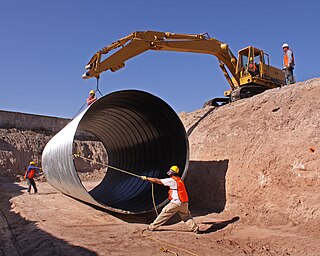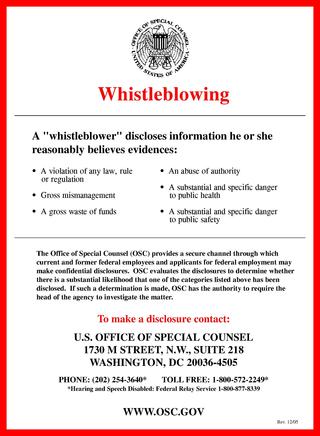The Occupational Safety and Health Administration is a regulatory agency of the United States Department of Labor that originally had federal visitorial powers to inspect and examine workplaces. The United States Congress established the agency under the Occupational Safety and Health Act, which President Richard M. Nixon signed into law on December 29, 1970. OSHA's mission is to "assure safe and healthy working conditions for working men and women by setting and enforcing standards and by providing training, outreach, education, and assistance." The agency is also charged with enforcing a variety of whistleblower statutes and regulations. OSHA's workplace safety inspections have been shown to reduce injury rates and injury costs without adverse effects on employment, sales, credit ratings, or firm survival.

Workers' compensation or workers' comp is a form of insurance providing wage replacement and medical benefits to employees injured in the course of employment in exchange for mandatory relinquishment of the employee's right to sue his or her employer for the tort of negligence. The trade-off between assured, limited coverage and lack of recourse outside the worker compensation system is known as "the compensation bargain.” One of the problems that the compensation bargain solved is the problem of employers becoming insolvent as a result of high damage awards. The system of collective liability was created to prevent that and thus to ensure security of compensation to the workers.

The Occupational Safety and Health Act of 1970 is a US labor law governing the federal law of occupational health and safety in the private sector and federal government in the United States. It was enacted by Congress in 1970 and was signed by President Richard Nixon on December 29, 1970. Its main goal is to ensure that employers provide employees with an environment free from recognized hazards, such as exposure to toxic chemicals, excessive noise levels, mechanical dangers, heat or cold stress, or unsanitary conditions. The Act created the Occupational Safety and Health Administration (OSHA) and the National Institute for Occupational Safety and Health (NIOSH).
An administrative law judge (ALJ) in the United States is a judge and trier of fact who both presides over trials and adjudicates claims or disputes involving administrative law. ALJs can administer oaths, take testimony, rule on questions of evidence, and make factual and legal determinations.
This article gives detailed information on the employment situation in Hong Kong.
The Division of Occupational Safety and Health of California is an agency of the Government of California established by the California Occupational Safety & Health Act of 1973.
Right to know is a human right enshrined in law in several countries. UNESCO defines it as the right for people to "participate in an informed way in decisions that affect them, while also holding governments and others accountable". It pursues universal access to information as essential foundation of inclusive knowledge societies. It is often defined in the context of the right for people to know about their potential exposure to environmental conditions or substances that may cause illness or injury, but it can also refer more generally to freedom of information or informed consent.

The Oklahoma Department of Labor (ODOL) is an agency of the government of Oklahoma that is headed by the Oklahoma Labor Commissioner, a statewide elected position. ODOL is responsible for supervising the administration of all state laws relating to labor and workplace safety and gathers and publishes information about the workforce of Oklahoma.
The New York State Department of Labor is the department of the New York state government that enforces labor law and administers unemployment benefits.

WorkSafe Victoria is the trading name of the Victorian WorkCover Authority, a statutory authority of the state government of Victoria, Australia.
The Maryland Department of Labor is a government agency in the U.S. state of Maryland. It is headquartered at 1100 North Eutaw Street in Baltimore.
Iowa Workforce Development is a government agency in the American state of Iowa, responsible for overseeing workplace safety, workers' compensation, unemployment insurance and job training services. It was formed in May 1996.

The California Labor Code, more formally known as "the Labor Code", is a collection of civil law statutes for the State of California. The code is made up of statutes which govern the general obligations and rights of persons within the jurisdiction of the State of California. The stated goal of the Department of Industrial Relations is to promote and develop the welfare of the wage earners of California, to improve their working conditions and to advance their opportunities for profitable employment."
The Energy Employees Occupational Illness Compensation Program Act (EEOICPA) was passed by Congress in 2000 and is designed to compensate individuals who worked in nuclear weapons production and as a result of occupational exposures contracted certain illnesses. EEOICPA was signed into law by President Bill Clinton on October 30, 2000.

A whistleblower is a person who exposes any kind of information or activity that is deemed illegal, unethical, or not correct within an organization that is either private or public. The Whistleblower Protection Act was made into federal law in the United States in 1989.
The California Labor and Workforce Development Agency (LWDA) is a cabinet-level California state agency that coordinates workforce programs by overseeing seven major departments dealing with benefit administration, enforcement of California labor laws, appellate functions related to employee benefits, workforce development, tax collection, economic development activities. It was conceived by Governor Gray Davis and was formally created by S.B. 1236 in 2002.

The Wisconsin Department of Workforce Development (DWD) is an agency of the Wisconsin state government responsible for providing services to Wisconsin workers, employers, and job-seekers to meet Wisconsin's workforce needs. To effect its mission, the Department administers unemployment benefits and workers' compensation programs for the state of Wisconsin; ensures compliance with state laws on wages and discrimination; provides job resources, training, and employment assistance for job-seekers; and engages with employers to help them find and maintain adequate staffing for their businesses.
The Washington State Department of Labor and Industries (L&I) is a department of the Washington state government that regulates and enforces labor standards. The agency administers the state's workers' compensation system, conducts workplace inspections, licenses and certifies trade workers, and issues permits for heavy machinery.
Workers' compensation in the United States is a primarily state-based system of workers' compensation.







